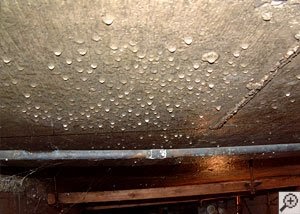Humidity is the permeation of water in a body or the high concentration of water vapor in the air. In predictive maintenance, humidity is diagnosed as a failure when it is observed at inspection points where there should be no humidity.

Causes
The most common causes of moisture detectable by visual inspection are:
- Water or other liquid leaks.
- Condensation of water in components.
- Spillage of liquids.
- Bad drainage.
- Liquid leaks.
- Absorption of water in the environment.
- Poor storage conditions.
- Wear waterproof material.
Cases
Through visual inspections the most common cases of humidity that are diagnosed are:
- Facades of buildings, walls, walls, and ceilings.
- Drywall.
- Thermal insulation.
- Air filters.
- Foundations of machinery, structures, and substations.
- Metallic structures.
Diagnosis
Detection of moisture in visual inspections is by direct and indirect observation. Direct observation is generally when there is a condensation of water on the surface. Indirect observation is when the effects of moisture are visualized: mold, discoloration or staining, corrosion, material degradation, paint peeling, adhesive failure, or even material fragmentation.
Points to consider:
- When the source of moisture is detected, consider diagnosing the leak rather than moisture fault.
- It is common that when detecting humidity simultaneously, other related failures are reported, such as corrosion, obstruction, deterioration, dirt, leaks, mismatch, and corrosion.
- Sometimes detailed inspections must be made to detect moisture in specific cases. This is common in infrastructure and real estate maintenance. Checklists, construction testing, and air pressure mapping are often done. These tests are generally not considered periodic visual inspections.
